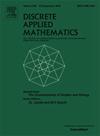时间图中最大团的输出敏感枚举
IF 1
3区 数学
Q3 MATHEMATICS, APPLIED
引用次数: 0
摘要
社区检测是图分析的基本任务之一,而代表节点完全互联子集的团块是社区的原型模型之一,通常关注那些在包含下最大的节点。近年来,时间图的重要性有所增加,即边缘可以自由出现和消失的图。这种情况引发了一波研究浪潮,致力于理解时间结构,以及如何使经典的图方法适应这种更复杂的模型。已经提出了对团的一些适应,以及寻找最大团的算法。然而,这些都没有产出敏感的保证,这意味着可以花费大量时间来寻找少数解决方案。在本文中,我们展示了两种不同的时间图模型,以及相应的团的定义,在本质上是等效的,允许我们考虑一个单一的团的模型而不失去一般性;此外,我们开发了一种输出敏感算法,用于在每个边存在于连续间隔的受限场景中找到所有最大团:该算法使用多项式空间在多项式总时间内运行,或者如果我们允许指数空间使用,则在增量多项式时间内运行。虽然受限制的场景限制了结果的通用性,但目前还没有针对该问题的输出敏感算法,因此这是第一个这样的结果,也是在时间图中进行输出敏感社区检测的第一步。本文章由计算机程序翻译,如有差异,请以英文原文为准。
Output-sensitive enumeration of maximal cliques in temporal graphs
Community detection is one of the fundamental tasks in graph analysis, and cliques, representing a fully interconnected subset of nodes, are one of the archetypal models of community, typically focusing on those that are maximal under inclusion. Recent years witnessed an increase in prominence of temporal graphs, i.e., graphs where edges may freely appear and disappear. This scenario caused a wave of research devoted to understand the temporal structure, and how to adapt classical graph methods to this more complex model. Several adaptations have been proposed for cliques, as well as algorithms for finding maximal cliques. These, however, do not have output-sensitive guarantees, meaning considerable time could be spent to find a small number of solutions.
In this paper, we show how two different proposed models of temporal graphs, and the corresponding definitions of clique, are essentially equivalent, allowing us to consider a single model of clique without losing generality; furthermore, we develop an output-sensitive algorithm for finding all maximal cliques in the restricted scenario where each edge is present for a continuous interval: the algorithm runs in polynomial total time using polynomial space, or in incremental polynomial time if we allow exponential space usage.
While the restricted scenario limits the generality of the result, no output-sensitive algorithm for the problem exists as of yet, making this the first such result, and a first step into output-sensitive community detection in temporal graphs.
求助全文
通过发布文献求助,成功后即可免费获取论文全文。
去求助
来源期刊

Discrete Applied Mathematics
数学-应用数学
CiteScore
2.30
自引率
9.10%
发文量
422
审稿时长
4.5 months
期刊介绍:
The aim of Discrete Applied Mathematics is to bring together research papers in different areas of algorithmic and applicable discrete mathematics as well as applications of combinatorial mathematics to informatics and various areas of science and technology. Contributions presented to the journal can be research papers, short notes, surveys, and possibly research problems. The "Communications" section will be devoted to the fastest possible publication of recent research results that are checked and recommended for publication by a member of the Editorial Board. The journal will also publish a limited number of book announcements as well as proceedings of conferences. These proceedings will be fully refereed and adhere to the normal standards of the journal.
Potential authors are advised to view the journal and the open calls-for-papers of special issues before submitting their manuscripts. Only high-quality, original work that is within the scope of the journal or the targeted special issue will be considered.
 求助内容:
求助内容: 应助结果提醒方式:
应助结果提醒方式:


